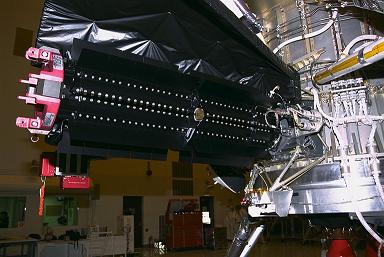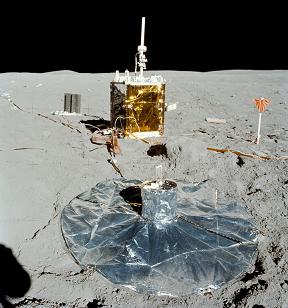In a previous post we presented the most common solution for power generation onboard unmanned spacecrafts (solar cells and secondary batteries) and mentioned some of the manned spacecrafts that employ this solution.
However, solar cells, in combination with secondary batteries, are not usable for missions beyond the asteroid belt, because there the sun’s energy becomes too diffuse. As deep space missions were designed, a new power source was required. The radioisotope thermoelectric generators, also known as RTGs, met the requirements for this kind of mission. RTGs are proven, compact, and reliable power sources that can produce up to several kilowatts of power and operate under severe conditions for many years.
RTGs convert the heat generated by a decay of radioactive fuel into electricity. There are two major components that RTGs consist of: the heat source that contains the radioactive material and a set of solid-state thermocouples that convert the heat energy to electricity. The principle that RTGs rely on is not a new discovery. In 1821, Thomas Johann Seebeck discovered the effect that bears his name and that allows us to convert heat directly into electricity using a simple and robust device. An electrical current is generated when two dissimilar electrically conductive materials are connected in a closed circuit and their junctions are kept at different temperatures. The heat generated by the radioactive decay is used to heat the hot junction of the thermocouple, and exposure to the cold outer space is used to maintain the temperature of the cold junction.
Over the years, RTGs have been used safely and reliably on many missions. Among these missions: some of the Apollo flights to the moon, the Pioneer spacecrafts, the Viking landers, the Voyager missions, the Galileo mission, the Ulysses mission, and the Cassini-Huygens mission. The present conversion efficiency achieved by the thermocouples is around 10%, and research continues in order to improve it. Because of the internal resistance and other losses, the overall RTG efficiency is typically 6-7%, which means that the amount of waste heat for every unit of electrical energy produced is quite large.
Even if the radioisotopes used present a loss in energy with time, the half-life of the radioisotopes is not a major life-limiting factor of current RTGs. Major life-limiting factors include the degradation of the thermoelectric elements and the breakdown of insulators because of temperature and radiation.
The radiation emissions from RTGs can damage the electronics onboard spacecrafts. This is why it is necessary to mount the units on booms at some distance from the body of the spacecraft or, at least, provide shielding of some sort in the on orbit configuration. One important thing to mention is that in the launch configuration, when the RTG boom cannot be deployed, the radiation exposure cannot exceed the inherent radiation tolerance of the onboard electronics.
There are two more solutions spacecraft engineers employ to generate power onboard spacecrafts and we will present them in our next post. Please come back later to read our conclusion to the series.











 Subscribe to our RSS feed
Subscribe to our RSS feed











There are no comments.
Add A Comment